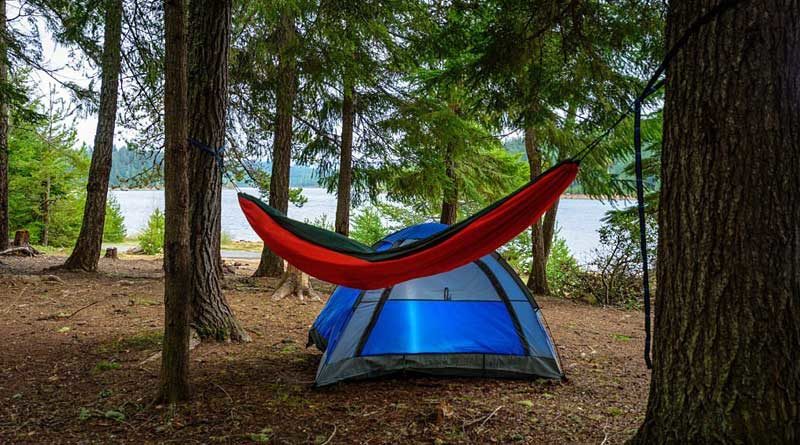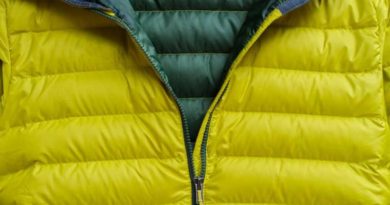How to Keep Sleeping Pad from Sliding in a Hammock?
Using a sleeping pad in a hammock is frustrating because the sleeping pad tends to slide from underneath. It is very difficult to readjust the pad inside the hammock. You would have to get out most probably. To keep your sleeping pad from sliding in a hammock, invest in a double-layer hammock or an underquilt protector by 2QZQ which would eliminate the problem. Other methods include placing the pad diagonally, loosening the hammock, and keeping your foot side higher than your head side. The cheapest long-term way is to use silicon-based adhesives.
For more details, keep reading.
The Fabric of the Hammock
The fabric of the hammock plays an important role in determining how much your sleeping pad will slide around. The fabric used in hammocks is either cotton or nylon or maybe a blend of the two. Some manufacturers brush the fabric so much that it becomes slippery making it difficult for even a person to stay in place, let alone a pad. If you have a hammock with slippery fabric, perhaps, you should consider getting another hammock. A hammock with a fabric that isn’t slippery can make a huge difference in how much your sleeping pad slides around.
The Type of Sleeping Pad
What type of sleeping pad you use is another determining factor of how much it will slide in the hammock. There are two major types of sleeping pads; foam and air sleeping pads. Foam sleeping pads don’t slide around much because of their structure. Air pads, on the other hand, are a different problem. If you can use a foam pad in your hammock, then doing so can reduce the problem of the pad sliding around. But there are situations where you need more warmth than a foam pad can provide meaning you are stuck with an air pad.
The Inherent Problem with an Air Pad
Being filled with air, an air pad is just an oversized balloon. If you let an air balloon loose, it will keep floating around. Try putting something on that balloon or resting your head on it and you will know why an air pad is a way it is. Air pads are inherently slippery.
The reason why air pads float and slide around is that there is no mass inside them to keep them from sliding around. But how does mass help? Well, fill a balloon with water and it will take some effort to role. Fill it with rocks….and you get the point. Modern “lightweight” air pads slide around even more.
But filling an air pad with something isn’t feasible. Filling the air pad with insulation would turn it into another sleeping bag. It will become heavy and more difficult for you to store and carry, not what pads were made for. Weight and packability are two major reasons why many people avoid foam and self-inflating pads.
Another good reason for filling the pad with air is that air is among the worse conductors of heat than many solid materials. The insulation benefits of air along with having the least weight make it the perfect candidate to be used in sleeping pads.
The Easy Fixes
Here are a few easy fixes to prevent your sleeping pad from sliding around. These fixes would require you to spend some money to get rid of the problem instantly and permanently. No time waste through trial and error and no tedious setup.
Buy an Underquilt
Why on earth are you using a sleeping pad in a hammock anyway? I mean, surely you are not that desperate. Sleeping pads are not meant to be used in a hammock – even when they advertise it as a hammock sleeping pad. Sleeping pads are used as a last resort in a hammock. Just buy yourself a good underquilt and get over the problem.
Having not enough budget is a different problem. But many newbies don’t invest in an underquilt because they aren’t sure if it’s the right decision or if it’s too much commitment. If you can, just buy one. There is no reason to hold back. Make your life easier. There is a lot more to life than struggling with a sliding sleeping pad in a hammock.
Buy a Double-Layer Hammock
Underquilts are expensive so not everyone can afford them. In that case, you can buy a double-layer hammock. Double-layer hammocks allow you to place the sleeping pad between the layers. Some hammocks even have a zipper to secure the pad in its place. A double-layer hammock setup has some benefits:
- The pad is not directly under you making it more comfortable for you to lie down in your hammock.
- The pad stays in place without you doing anything. With an underquilt, you would still have to put in a lot of time to tie and set it up. An underquilt takes almost the same amount of effort as setting up the hammock. With a double-layer hammock, you just put your pad in between the layers. The only time and effort you would have to put in are to inflate the pad if you have an air sleeping pad.
- An underquilt is heavy and bulky. A double-layer hammock with an air pad would take a lot less space in your backpack and weigh a lot less as well.
- Double-layer sleeping pads are much more budget-friendly than underquilts. If you can’t buy an underquilt, then invest in a double-layer hammock.
Buy a 2QZQ Underquilt Protector
2QzQ specializes in hammock accessories. A 2QZQ underquilt protector is the most budget-friendly option you can get. Since it goes under the hammock, it forms a second layer under the hammock without the underquilt turning a normal hammock into a double-layer hammock. You can use it to hold the sleeping pad underneath the hammock enjoying the same comfort of a double-layer hammock. 2QZQ has even tweaked the design to hold a sleeping pad in place.
The Time-Consuming Ways
There can be many reasons why you wouldn’t want to benefit from the easy ways mentioned above. Perhaps, you are tight on budget. Or maybe you are just stubborn and want to solve the problem without spending a dime. You call yourself a scientist. But for whatever reason, here are a few hard ways to prevent the sleeping pad from sliding in the hammock. Note that these methods will consume a lot of time because they require trial and error to get them working the way you want.
Use a Silicon-Based Adhesive
Using a silicon-based adhesive is a popular way to keep a sleeping pad from sliding among campers. It is a long-term solution and is extremely cheap. The adhesive is used to make beads on the surface of the pad that works as grips to hold the pad in place. These adhesives are easily available at nearby stores. This method is also used to keep sleeping bags on pads.
But using a silicone adhesive requires time and planning. This is not a last-minute technique. You can make these beads in your free time but if you remember at the last minute, you would have to do without them. The beads require 24 hours to dry. Here are a few easy steps to make beads on your pad:
- Wash your pad. Either follow the manufacturer’s instructions to wash your pad or use soap and water. Let the pad dry. The purpose of the wash is to get rid of dust and oil buildup. Dust and oil prevent adhesives to stick properly.
- Make beads with the adhesive on the underside of the pad in the middle and around the edges. More beads mean more grip. The torso area is where the pad slips and slides the most so make more beads in this area.
- Let the pad sit for 24 hours before packing the pad for your trip.
Let Some Air Out
A common belief among campers is that the more you inflate the pad the more comfortable it becomes. Everyone tries to fill the pad with as much air as their innocent lungs can. That is not a good idea. An overinflated air pad becomes more bouncy just like an overinflated tire. An overinflated tire gives less traction. Similarly, the more bouncy the mattress is, the more it slides around. An overinflated pad would make you slip off of it easily.
Since you won’t have the problem of touching the ground in a hammock, like during ground camping, you can deflate the pad a little. With less air, the pad also conforms to the shape of the body by allowing the body to sink in, resulting in more comfort. A deflated pad is also more stable because it is flatter. But you would have to put in some time to find out the right amount of air you need in your pad through trial and error.
Buy the Right Size
If you are using an air mattress, many articles on the internet would tell you to get a wider size to overcome the slipping and sliding problem. While this may sound intuitive, not every piece of advice on the internet is good advice.
When you lie down on an air pad, the air moves outwards where your body weight is not present. As a result, the pad seems pressed in the middle – where your body is – and inflated at the edges. In a wider pad, there is more room for air to move. To keep the pad inflated adequately, you would have to overinflate it which brings us back to the problem mentioned above.
Buying a wider size is a good strategy with closed-cell foam pads but it only makes matters worse with an air sleeping pad.
Loosen the Hammock
Tying the hammock as tightly as possible is another bad idea. A tighter hammock doesn’t let the sleeping pad lay properly. Releasing the tension on the anchor points and allowing the hammock to sag, lets the sleeping pad sink in reducing the chance of sliding around. A loose hammock is also more comfortable than a tight hammock and keeps the body and sleeping pad in one position.
Put the Pad Diagonally
Lying in a hammock diagonally provides more stability to the hammock and is also more comfortable as it allows the head and feet to hang freely. Hammocks were designed for people to sleep in a diagonal position but not many hammock campers know this.
Putting your sleeping pad in the center doesn’t allow it to spread flat making it more susceptible to sliding from under you. Putting the diagonally allows it to fully spread out distributing your bodyweight throughout its surface reducing the sliding issue significantly. If you have never slept diagonally in your hammock before, you would have to find the right spot for yourself.
Lift your Foot Side Above the Head Side
If you set the ends of a hammock at equal heights, it makes your body and sleeping pad position themselves at the center of the hammock which brings us back to the same problem mentioned above. For that reason, you should hang your foot side some 8 to 19 inches higher than your head side.
Lifting the foot side makes your upper body stay away from the center which in turn keeps your sleeping pad from sinking into the center. This is a proven way of keeping your sleeping pad from sliding while you sleep.
This position is also more comfortable as your body weight is distributed on your back rather than your butt. Your back is a larger surface area than your butt. If your bodyweight gets distributed over your butt, it will cause you discomfort after some time.
Raising your feet above your head is also beneficial for your feet if you have hiked for long distances before setting up camp. Long hikes can make your feet swell. Raising your feet above your head quickly reduces the swelling in your feet.




